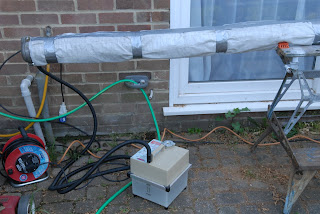Some time back, I generated a 3D computer model of the galley (see the photo album link) to gain some visual idea for the final result and to try out various changes without major expense.
I had wanted to gimbal the cooker and to allow for a 10 degree swing either way, the cooker surround needed to be a lot bigger than originally fitted.
At 10 degrees (the maximum I could work in) the computer model suggested that the cooker surround (the big box in the middle of shot) would foul the hull around the chine log. Sure enough, when moving the box into position it stopped short by about 30mm. The box was removed and a 50 x 50 bevel planed off the bottom corner allowing the box to be fitted in its correct position.
Of course I now need to fill in the hole and fit the framing, but it's nice when the computer is right for once :-)
The photos shows the state of play at the end of the day. Galley worktop sub-layer in place with the holes cut for the sink and tap. The cooker box in place and with some of the framing installed. the most useful tool in shot is the red right-angle gearbox for the drill. It allows you to drill round corners and means that the holes in the worktop under the side deck can be drilled and countersunk at the right angle.
And why would you want a gimballed cooker on a motorboat?
Answer: Well, if you've ever been on a Fairey, anchored somewhere nice and then you find she's sitting sideways to wherever the swell is arriving from, you'll need somewhere to put your mug of tea so it doesn't spill - wedged in the pan holders on top of the galley stove. It also works for G&T's
[Now Playing: Welcome To The Machine


